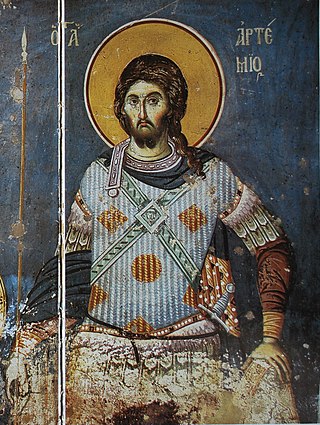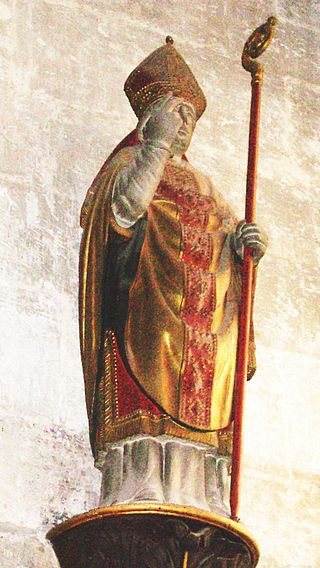Related Research Articles

Gavinus is a Christian saint who is greatly celebrated in Sardinia, Italy, as one of the Martyrs of Torres, along with his companions Protus, a bishop, and Januarius, a deacon.
Saints Marius, Martha, Audifax, and Abachum were, according to their largely legendary passio of the 6th century, four saints of the same family. They came from Persia to Rome, and were martyred in 270 for sympathizing with Christian martyrs and burying their bodies. Some ancient martyrologies place the date of their death between 268 and 270, during the reign of Claudius II, although there was no persecution of Christians during this time.

The Four Crowned Martyrs or Four Holy Crowned Ones were nine individuals who are venerated as martyrs and saints of Early Christianity. The nine saints are divided into two groups:
- Severus, Severian(us), Carpophorus (Carpoforus), Victorinus
- Claudius, Castorius, Symphorian (Simpronian), Nicostratus, and Simplicius

Artemius, also known as Shallita, spelt Shalita or Chalita was a Syrian general of the Roman Empire and dux Aegypti or imperial prefect of Roman Egypt. He is considered a saint by the Catholic and the Orthodox Churches, by the name of Artemius of Antioch, Mar Shalita of Antioch, and Mar Shalita the Martyr.

January 26 - Eastern Orthodox liturgical calendar - January 28

Constantius of Perugia is one of the patron saints of Perugia, Italy.
Saint Gabinus is the title given to two personages.

Saint Anthimus of Rome, or Sant'Antimo in Italian, is a Christian saint. His life is largely composed of legend. He is said to have been born in Bithynia. A Christian priest, he was imprisoned for his beliefs at the time of the Emperors Diocletian and Maximian. His feast day is May 11.

Saints Victor and Corona are two Christian martyrs. Victor was a Roman soldier who was tortured and killed; Corona was killed for comforting him. Corona is invoked as a patron of causes involving money; she was not historically associated with pandemics or disease, but has been invoked against the coronavirus pandemic.
Saint Caesarius of Terracina was a Christian martyr. The church of San Cesareo in Palatio in Rome bears his name. He is venerated as a saint in the Eastern Orthodox Church and Roman Catholic Church, with a feast day on 1 November.

Saints Marcellinus and Peter are venerated within the Catholic Church as martyrs who were beheaded. Hagiographies place them in 4th century Rome. They are generally represented as men in middle age, with tonsures and palms of martyrdom; sometimes they hold a crown each.

Saint Maximus of Évreux, called Saint Mauxe locally, is venerated as a saint by the Catholic Church and the Eastern Orthodox Church. His legend states that he was the second bishop of Évreux, and that he died a martyr at Acquigny with his brother, who was his deacon. His brother is called Venerandus (Vénérand) or Victorinus.
Chiaffredo is venerated as the patron saint of Saluzzo, Italy. Tradition considers him a member of the Theban Legion, but instead of being martyred with this legion at Agaunum, he escaped to Piedmont and was martyred there.

Saint Donatus of Arezzo is the patron saint of Arezzo, and considered a bishop of the city.

Constantius is venerated as a member of the legendary Theban Legion. Similar to the cults of Chiaffredo at Crissolo, Bessus at Val Soana, Tegulus at Ivrea, Magnus at Castelmagno, and Dalmatius at Borgo San Dalmazzo, the cult of Constantius was linked with that of the Theban Legion to lend antiquity to a local saint about whom nothing was really known.

Saint Paraskevi of Rome is venerated as a Christian martyr of the 2nd century. She was arrested on multiple occasions for her Christianity and was eventually beheaded by the Roman governor Tarasius.

Gaudentius of Rimini was a bishop of Rimini, who is venerated as a martyred saint in the Catholic Church and Eastern Orthodox Church.

Saint Venera is venerated as a Christian martyr of the 2nd century. Little is known of this saint. The date of her death is traditionally given as July 26, 143 AD.

The Catacomb of Generosa is a catacomb of Rome (Italy), located in Via delle Catacombe di Generosa, close to a big bight of river Tiber on the right bank, in the Portuense quarter.

Potitus was an early Christian martyr, venerated as a saint by the Roman Catholic Church and the Eastern Orthodox Church on 14 January.